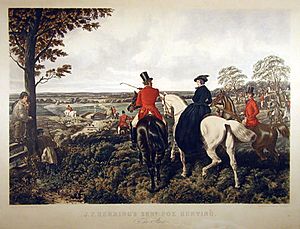William Taylor Copeland facts for kids
Quick facts for kids
Alderman, Lord Mayor
William Taylor Copeland
|
|
|---|---|

William Taylor Copeland (Mary Martha Pearson, 1835)
|
|
| Member of Parliament for Coleraine |
|
| Member of Parliament for Stoke upon Trent |
|
| Preceded by | Hon. George Anson |
| Succeeded by | John Ricardo |
| Personal details | |
| Born | 1797 London, England |
| Political party | Conservative |
| Other political affiliations |
Whig (until 1837) |
| Residence | Russell Farm |
| Website | [1] |
William Taylor Copeland (1797 – 1868) was an important British businessman and politician. He was known for leading a famous pottery company. He also served as the Lord Mayor of London and was a Member of Parliament.
Contents
Family and Business Life
William Taylor Copeland came from a family with a long history. His family's story goes back to John of Copeland. This John was famous for capturing the King of Scotland in 1346. This happened during a battle called the Battle of Neville's Cross.
Leading the Pottery Business
William was the only son of William Copeland. His father was a partner with Josiah Spode in a pottery business. This business was in Staffordshire and also in London. William Taylor Copeland took over the company after his father.
He eventually bought out the Spode family's share. This made him the full owner of the pottery business. From 1833 to 1847, he ran the company with a partner, Thomas Garrett. After that, the company became known as W.T. Copeland and Sons.
Other Business Ventures
In 1866, Copeland's company received a special honor. They were named china and glass manufacturers to the Prince of Wales. He also became a director for the London and Birmingham Railway Company. This was a major railway line.
Copeland was also a big investor in a coal mine. This mine was called Fenton Park Colliery. He was also a director of the North Staffordshire Railway Company. He held this position from 1846 to 1852.
He was even the first chairman of the Trent Valley Railway Company. He was appointed to this role in 1844. However, he resigned from this position in 1845.
Copeland's Family Life
In 1826, William Taylor Copeland married Sarah Yates. They had ten children together. Five of their children survived to adulthood. These included one daughter and four sons.
His sons were William Fowler Mountford Copeland, Edward Capper Copeland, Alfred James Copeland, and Richard Pirie Copeland. William's cousin, William Copeland Astbury, wrote about the family. He also wrote about the Copeland Spode business in his diaries.
An Artistic Legacy
William Taylor Copeland had a strong connection to art. He helped create "The Hunt" collection. This collection of everyday earthenware was first made in 1930. Its inspiration came from a famous artist.
Collaborating with John Frederick Herring
In 1830, Copeland offered a house to John Frederick Herring Sr.. Herring was a great artist known for painting sporting scenes. The house was on Copeland's estate in Essex. This led to a special relationship between the two men.
Herring created a collection of paintings for Copeland. Many of the scenes used for "The Hunt" pottery collection come from these paintings. Each piece of pottery shows its English heritage. It also represents over two centuries of tableware tradition.
John Frederick Herring was born in 1795. He often painted horses for important owners. Around 1830, he was in debt. William Taylor Copeland helped him by paying his bills. He also offered Herring a place to live.
Copeland asked Herring to paint his own racehorses. He also commissioned pictures of fox hunting. Herring also painted scenes of country life with horses. Most of the designs for "The Hunt" collection came from these artworks. Some designs also came from other sporting artists.
Public Service and Political Career
William Taylor Copeland was very active in public life. He played an important role in the City of London. In 1828, he was elected as an alderman for Bishopsgate ward.
Serving as Lord Mayor
He served as Sheriff of London and Middlesex from 1828 to 1829. In 1835, he was elected Lord Mayor of London. He was one of the youngest people to hold this important position. He served as Lord Mayor from 1835 to 1836.
Copeland was also a member of the Goldsmiths' Company. He was their master from 1837 to 1838. For seven years, he was president of two royal hospitals. These were Bridewell and Bethlem hospitals. He was also a member of the Irish Society. He was also the President of the Honourable Artillery Company. In 1834, he became the first President of Forest School.
Political Life as a Member of Parliament
Copeland was also involved in politics in Ireland. He was a member of the Whig political party. He ran for election in the Coleraine area. This was for the UK parliament in 1831 and 1832.
He lost the first vote both times. However, he was later declared the winner after a review. In the 1835 election, he was re-elected as MP for Coleraine. He won by a small majority of five votes. He served for this area until 1837.
After that, Copeland ran for election in England. He stood for the Stoke-upon-Trent area. This time, he was a candidate for the Conservative party. He served as the MP for Stoke-upon-Trent from 1837 to 1852. He lost his seat in 1852. However, he was re-elected in 1857. He continued to serve until he retired from politics in 1865.
See also
- William Henry Goss
- John Frederick Herring Sr.
- Spode


